千岛湖岛屿社鼠的种群数量动态特征
2013-12-08鲍毅新沈良良章书声方平福
张 旭,鲍毅新,刘 军,沈良良,章书声,方平福
(浙江师范大学生态研究所,金华 321004)
千岛湖岛屿社鼠的种群数量动态特征
张 旭,鲍毅新*,刘 军,沈良良,章书声,方平福
(浙江师范大学生态研究所,金华 321004)
2009年7月至11月以及2010年3月至11月在千岛湖地区2个岛屿上对社鼠(Niviventerconfucianus)种群进行标志重捕,通过对社鼠种群数量变动、更新率、居留时间以及气候对种群数量影响的研究,探讨在陆桥岛屿环境下社鼠种群数量动态的规律。结果显示:两岛种群数量均是上半年数量处于高峰,而下半年数量较低,超过环境承载力可能是种群下降的主要原因,岛屿环境对社鼠数量季节消长的影响与陆地环境有所不同;两岛社鼠的种群更新率均较低,这也说明在缺乏迁入和迁出的陆桥岛屿上,仅仅依靠出生和死亡来完成种群的更新,其种群更新率是较低的。根据对社鼠居留时间的研究,两岛上社鼠的生态寿命有可能只有一年左右,这比以往研究认为社鼠的生态寿命约一年半或更长一些明显缩短,这可能与陆桥岛屿较特殊的生存环境有关;月平均气温处于10—22 ℃对于社鼠种群的维持和增长是有利的,当月平均气温超过22 ℃时,似乎对社鼠种群是不利的。高温而少雨,可能是导致夏季社鼠种群数量下降的原因之一。
种群数量动态;种群更新率;居留时间;千岛湖岛屿;社鼠(Niviventerconfucianus)
生境片段化是近来生态学领域研究的热点[1]。在生境片段化过程中兽类成为最为脆弱的类群之一,生境片段化可能是许多兽类种群生存的最大威胁[2]。小型兽类处于生态系统的中心位置,其通过食物链或网及间接作用几乎和生态系统中的所有物种发生联系[3],因此研究生境片段化对小型兽类的影响具有重要意义。
岛屿化是一种典型的生境片段化,其有许多显著特征,如地理隔离,生物类群简单,动物区系组成和历史清楚的特点,再加上岛屿数量众多、不同岛屿在形状、大小和隔离度等方面都不相同,这些特点使得其成为生态学家检验理论和验证假说的天然实验室[4- 6]。近年来,国内外在岛屿隔离对植物[7- 11]、爬行类[12- 13]、鸟类[14- 19]等的影响方面已开展了较多的研究。另外,国内在对小型兽类的物种多样性[20]、年龄结构和繁殖状况[21]、个体形态[22]、巢区和领域[23]、遗传多样性[24]的影响方面也逐步开展了一些研究工作,并取得了一定的成果。
生境片段化导致原生境的总面积减小,产生了隔离的异质种群,影响到个体的行为特性[25- 26],进而影响到群落组成及种群动态[27- 29]。而生存于小生境片段中的小种群具有很高的绝灭风险[30]。种群动态是种群生态学的核心问题,而种群数量是种群动态研究的最基本内容。对于陆桥岛屿生境下鼠类种群数量动态的研究尚未见报道。因此,在探讨了陆桥岛屿环境下估算社鼠种群数量的适用方法[31]的基础上,选取千岛湖岛屿对社鼠的种群数量变动、种群更新率、种群居留时间以及气候对种群数量的影响进行研究,消除岛屿间的迁移和扩散等因素对其影响,验证假设:(1)陆桥岛屿环境对社鼠数量季节消长的影响与陆地环境有所不同;(2)社鼠通过种群水平上的一些改变来适应片段化生境,使种群得以延续。
1 研究方法
1.1 标志重捕
根据以往的经验,由于冬季12月至翌年2月环境温度较低,捕获鼠若在鼠笼内时间过长,食物不足、低温和产热过多会导致部分个体的死亡,从而影响研究的结果,因此在此期间不进行重捕。为了获得重复数据和便于对比分析,选取千岛湖地区面积适当、生境类型相似的两个岛屿作为研究样地。对A岛(2009年10月 — 11月以及2010年3月 — 11月)和B岛(2009年7月 — 11月以及2010年3月 — 11月)的社鼠种群进行标志重捕,所得数据采用修正Lincoln指数法计算两个岛屿上的社鼠种群数量。样地概况、标志重捕以及数量计算的方法参见文献[31]。
1.2 种群更新率
用以下公式对种群更新率进行分析[32]:

式中,θT是种群更新率,γ是T时间种群中存在的新个体的总数,NT是T时间种群总个体数量。
1.3 数据处理
采用SPSS 17.0数据分析软件对数据进行统计分析。相关性分析均采用线性回归,显著和极显著水平分别为P≤0.05和P≤0.01。作图均采用Excel 2003软件进行。
2 结果
2.1 种群数量动态
整个取样期间(2009年7月 — 11月以及2010年3月 — 11月)共标志社鼠177只,释放2240只次,其中A岛标志96只,释放1193只次;B岛标志81只,释放1047只次。分别用修正Lincoln指数法对两个岛屿上社鼠种群数量进行计算。
A、B两岛社鼠种群数量估算结果显示(图1),每月种群数量变化整体趋势基本一致,上半年数量处于高峰,而下半年数量较低。A岛6月(55.74只)和B岛4月(52.27只)均是在种群数量超过50只后开始下降,而B岛在6月之后数量相对于A岛下降的更快。
2.2 种群更新率
对社鼠种群更新率的计算结果表明(图2),两岛差异不显著(t=1.097,df= 9,P=0.301)。社鼠种群的更新率都比较低,除了2009年11月—2010年3月期间的种群更新率超过了50%,其他两个捕鼠期之间种群更新率均低于50%。
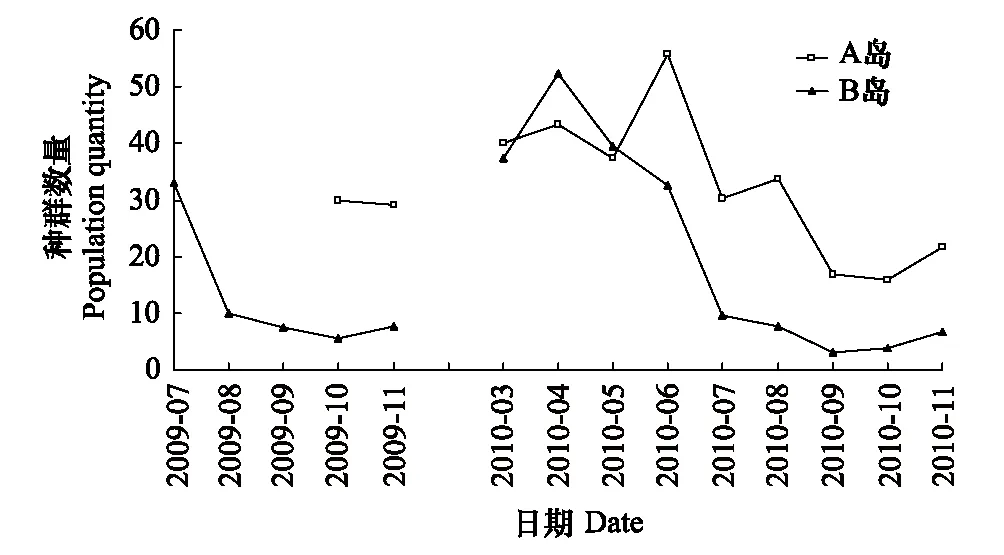
图1 两岛社鼠种群数量变化 Fig.1 Population dynamics of Niviventer confucianus in A and B islands
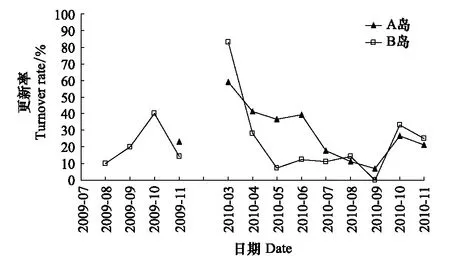
图2 两岛社鼠的种群更新率 Fig.2 Turnover rate of Niviventer confucianus population in A and B islands
2.3 种群个体居留时间
两岛在整个取样期间50%以上的个体均只捕到1—2次,A岛80%的个体捕5次以下,而B岛80%的个体捕4次以下;A岛最长居留时间为9个月,平均居留时间为(3.40±0.24)月;而B岛最长为11个月,平均居留时间为(3.20±0.27)月。从图3和图4中可以看到,A岛社鼠种群中雌雄个体的居留时间的差异显著(x2=15.894,df=8,P=0.044<0.05),雌性居留时间(4.20±0.38)月要长于雄性(2.55±0.24)月;而B岛与A岛有一定差异,社鼠种群中雌性(2.68±0.27)月和雄性(3.81±0.48)月个体的居留时间没有显著差异(x2=9.225,df=10,P=0.511>0.05)。
2.4 气候条件与种群数量的关系
2.4.1 月平均气温
经Pearson相关性检验结果显示,两岛月平均气温与种群数量均没有显著相关性(A岛:r=-0.04,df=11,P=0.906;B岛:r=-0.248,df=14,P=0.393)。但从图5可以看出,除B岛2010年4月外,月平均气温处于10—22 ℃对于社鼠种群的维持和增长是有利的,而当平均气温超过22 ℃(A岛:2010年6—9月;B岛2009年7—9月和2010年6—9月)时,种群数量则下降。
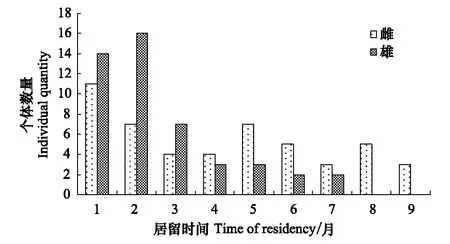
图3 A岛社鼠种群雌雄个体居留时间 Fig.3 Residence time of Niviventer confucianus population in A island

图4 B岛社鼠种群雌雄个体居留时间 Fig.4 Residence time of Niviventer confucianus population in B island
2.4.2 月降雨量
经Pearson相关性检验结果显示,两岛月降雨量与种群数量没有显著相关性(A岛:r= 0.393,df=11,P=0.232;B岛:r= 0.488,df=14,P=0.076)。A岛在气温较高的2010年6—9月,月降雨量除2010年7月之外都较低(图6);B岛在气温较高的2009年7—9月和2010年6—9月,月降雨量(除2009年7月和2010年7月外)较低(图6)。
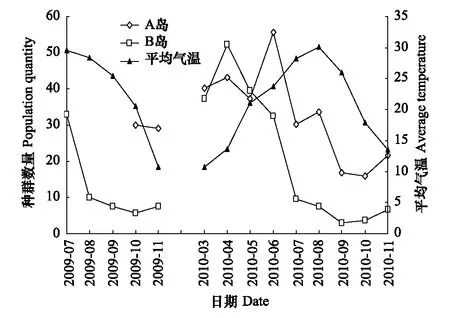
图5 两岛月平均气温与种群数量的关系 Fig.5 Monthly average temperature and population quantity in A and B islands
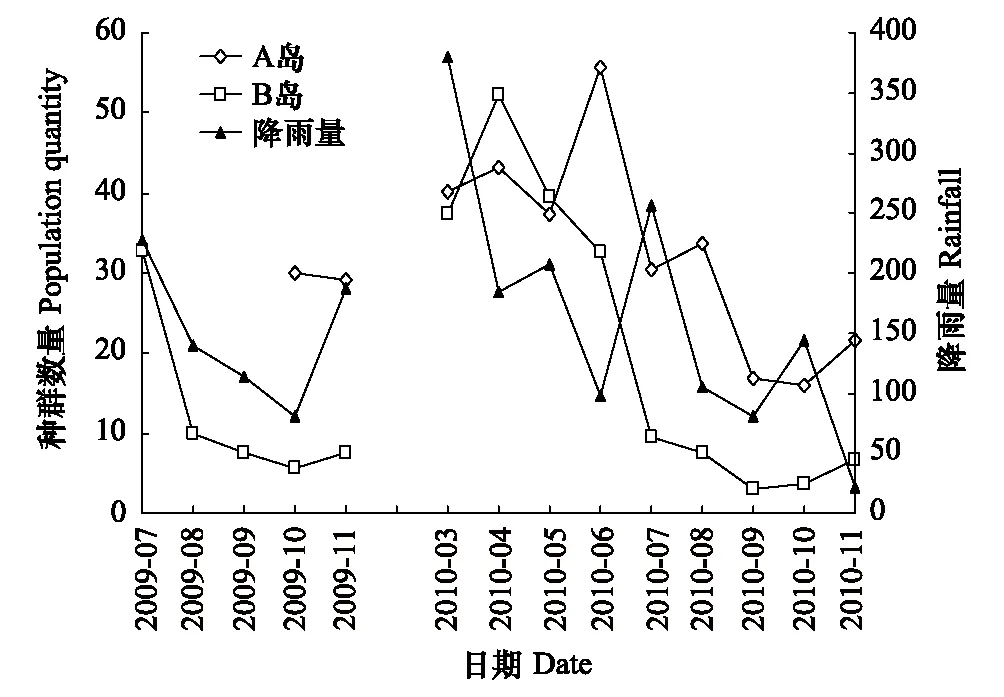
图6 两岛月降雨量与种群数量的关系 Fig.6 Monthly rainfall and population quantity in A and B islands
3 讨论
3.1 陆桥岛屿环境下的种群数量动态
千岛湖地区的岛屿是典型的片段化生境,是一种天然的围栏。一方面,因适宜生境斑块面积较小,生存所需的食物来源、活动范围等受到限制,生理机能处在较高的耐受状态,外界因素的影响作用明显加强,种群变得相对脆弱,波动性变大[27- 28,33];另一方面,围栏所导致的围栏效应(fence effect)会对孤立岛屿上的小型哺乳动物种群产生影响。例如,种群增长达到较高的密度后,由于资源的过度消耗,种群数量急剧下降[34]。作为孤立的岛屿,小型哺乳动物无法或很少能在岛屿间扩散,其种群数量受制于环境的容纳量。在一般情况下,一个岛屿的环境容纳量维持在相对稳定的水平,只有当环境发生较大的变化时环境容纳量才会发生较大的改变。本研究表明,在环境条件(面积、植被、气候等)相似的A、B两岛中,社鼠的种群数量在超过50只后均开始下降。可见,在面积和生境相似的岛屿上,环境承载力[35]也相似。因此,这是导致A岛6月后数量开始下降、B岛4月后数量开始下降的主要原因。
破碎的生境改变了原来生境能够提供的食物的质和量,同时也改变了隐蔽物的效能和物种间的联系,因此增加了捕食率和种间竞争[36]。兽类捕食者对种群密度的作用属于反密度制约类型,也就是捕食者只在猎物种群密度降低时发挥作用[37]。捕食的直接后果就是增大了猎物种群内的死亡率。另外,捕食风险还可能改变哺乳动物猎物的活动量,例如巢区和栖息地的利用、觅食和生殖方式等[38- 39]。猎物通过对捕食风险的反应,可能影响生殖适合度,最终导致种群数量下降[40]。而种间竞争也可以通过影响不同物种的栖息地利用,间接地影响竞争种群内个体的存活率[41- 43]。食物、捕食和种间竞争一起具有更强的累加效应[44- 45]。在研究过程中,发现虽然两岛的生境类型基本相似,但B岛上青毛硕鼠(Berylmysbowersi)的数量要明显多于A岛,而且6—8月在该岛上发现有野猪活动的痕迹,因此种间竞争和捕食可能对该岛种群数量变动的影响较大,这也许是导致B岛在6月之后数量相对于A岛下降的更快的主要原因。
另外,岛屿环境的特殊性会对社鼠种群数量的季节性变化产生一定的影响。根据Terborgh等[46]的研究方法结合研究区域的实际情况,可将千岛湖的岛屿依据面积(S)划分为 3 种类型:大型岛屿(S>30 hm2)、中型岛屿(2 hm2 3.2 种群更新和居留时间 研究种群的更新,是了解种群数量动态的重要内容之一[51]。本研究表明社鼠的种群更新率较低,这也说明在缺乏迁入和迁出的陆桥岛屿上,仅仅依靠出生和死亡来完成种群的更新,其种群更新率是较低的。 生境的破碎化导致生境面积的缩小对于动物种群存在一定的生存压力。对鸟类的研究表明,生境斑块的面积缩小对种群遗传状况的影响主要通过减小局部种群来改变一系列微进化过程[52],如近交衰退,随机漂变等。刘军等[24]通过对千岛湖13个岛屿上社鼠的种群遗传信息及遗传多样性与生境面积之间的相关性分析,从分子水平上推测千岛湖地区生境面积的缩小可能引发社鼠种群快速进化,以适应相对狭小的生存空间。而片段化生境同样也导致社鼠在种群水平上发生了改变,千岛湖中型岛屿9—10月社鼠的平均胎仔数达到5.17只[21],明显高于相近纬度浙江金华社鼠的3.77只[53]和洞庭湖区的3.7只[54],与纬度较高的北京地区的5.2只[55]和天津地区的4.5只[48]相接近。而本研究中,根据社鼠的居留时间,考虑到幼鼠从出生到能独立生活需要一定的时间,同时由于幼年鼠个体小,容易铁丝孔中逃出鼠笼,降低重捕率,以及捕食、疾病等造成个体的死亡等因素,两岛上社鼠的生态寿命有可能只有一年左右,这比以往研究认为社鼠的生态寿命达一年半以上明显缩短[55]。动物的生态寿命反映了生存条件的优劣,生态寿命长,说明生存条件优越[56]。陆桥岛屿环境下,其生存条件较为特殊,其生态寿命缩短。对个体小的物种,由于寿命的缩短,促使性早熟而早生后代,后代生育时间缩短,世代更新变快,这样能产生更多具遗传异质性的后代,生态适应幅度增大,进化速度变快[57]。因此,社鼠通过增加胎仔数、缩短生态寿命、改变更新率和居留时间等种群水平上的变化来适应片段化生境,使种群得以延续。 3.4 气候条件与种群数量的关系 气候条件是影响鼠类种群数量变动的重要因素之一,其通过影响鼠类的繁殖成功率[58]、生存环境的食物和隐蔽条件[59]等而影响种群数量。Pennycuik[60]和Triggs[61]认为小家鼠(Musmusculus)的种群数量变化与气候变化(如温度和降水量)有关。陈安国等[62]认为,气温、积雪等对新疆的小家鼠数量变化有影响。 本研究表明,月平均气温处于10—22℃对于社鼠种群的维持和增长是有利的。气温稳定在10 ℃以上,可能是鼠类进行繁殖的必要温度[49]。一般认为,平均气温达到10 ℃是进入春季的标准[63],千岛湖高覆盖的森林植被与水体调温的综合效应,形成了春暖早,秋寒迟的特殊小气候,无霜期达到263 d[64],而这一特点一方面就使鼠类的繁殖期开始较早,而繁殖期开始早晚对当年种群的季节性变化特点及全年的种群数量水平都有较大影响,较早地开始繁殖会有利于越冬成体繁殖更多的胎数,使当年生个体尽早成熟参加繁殖以补充越冬成体的死亡,从而有利于其数量的增长[56]。另一方面有利于植物生长,为鼠类提供了丰富的食物和良好的隐蔽条件。适宜的气温、充沛的雨水和优越的食物条件都利于鼠类繁殖,促使其数量增加。虽然社鼠能通过各种生理、行为的调节来适应温度的变化,对温度具有较强的耐受性,但从本研究结果来看,当月平均气温超过22 ℃时,似乎对社鼠种群也是不利的。 已有研究发现,年降雨量是影响长爪沙鼠(Merionesunguiculatus)种群数量的最重要的气候因子[65- 66]。关于降雨量对啮齿动物种群数量的影响,张知彬和王祖望[67]认为,雨量对不同鼠类的影响是不一致的,如夏季降雨对红背鼠平(Clethrionomysrutilus)、大林姬鼠(Apodemuspeninsulae)、长爪沙鼠种群增长有利,但对小家鼠、大仓鼠(Cricetulustriton)、黑线仓鼠(Cricetulusbarabensis)却不利。本研究中,在气温较高的6—9月,较低的月降雨量对社鼠种群是不利的。气温和降水量等气候因素是彼此相互联系、相互影响的,并非单独地对鼠类种群数量和变动发生作用,而是综合对种群发生作用[68]。高温而少雨,可能是导致夏季社鼠种群数量下降的原因之一。 [1] Laurance W F, Lovejoy T E, Vasconcelos H L, Bruna E M, Didham R K, Stouffer P C, Gascon C, Bierregaard R O, Laurance S G, Sampaio E. Ecosystem decay of Amazonian forest fragments: a 22-year investigation. Conservation Biology, 2002, 16(3): 605- 618. [2] Bright P W. Habitat fragmentation-problems and predictions for British mammals. Mammal Review, 1993, 23(3/4): 101- 111. [3] Zhang Z B. The role of small mammals in the ecosystem // Biodiversity Committee of Chinese Academy of Sciences. Biodiversity Studies Series No. 1 Principles and Methodologies of Biodiversity Studies. Beijing: Science and Technology Press of China, 1994: 210- 217. [4] MacArthur R H, Wilson E O. The Theory of Island Biogeography. New Jersey: Princeton University Press, 1967. [5] Williamson M H. The MacArthur and Wilson theory today: true but trivial. Journal of Biogeography, 1989, 16: 3- 4. [6] Vitousek P M. Oceanic islands as model systems for ecological studies. Journal of Biogeography, 2002, 29(5/6): 573- 582. [7] Terborgh J, Feeley K, Silman M, Nuez P, Balukjian K. Vegetation dynamics of predator-free land-bridge islands. Journal of Ecology, 2006, 94(2): 253- 263. [8] Zhang X, Xu G F, Shen D W, Gu Y J, Gao H, Luo X H, Chen X Y. Maintenance and natural regeneration of Castanopsis sclerophylla populations on islands of Qiandao Lake Region. Acta Ecologica Sinica, 2007, 27(2): 424- 431. [9] Terborgh J W, Feeley K J. Ecosystem decay in closed forest fragments // Tropical Forest Community Ecology. Oxford: Blackwell Publishing, 2008: 308- 321. [10] Sun Q, Lu J B, Wu J G, Zhang F F. Effects of island area on plant species distribution and conservation implications in the Thousand Island Lake region. Biodiversity Science, 2008, 16(1): 1- 7. [11] Sun Q, Lu J B, Zhang F F, Xu G F. Plant species diversity in relation to island size. Acta Ecologica Sinica, 2009, 29(5): 2195- 2202. [12] Shou L, Du W G, Lu W W. The causal analysis of inter-population variation in life histories of the northern grass lizard Takydromus septentrionalis: between-island differences in thermal environment, food availability and body temperature. Acta Zoologica Sinica, 2005, 51(5): 797- 805. [13] Wang Y, Zhang J, Feeley K J, Jiang P, Ding P. Life-history traits associated with fragmentation vulnerability of lizards in the Thousand Island Lake, China. Animal Conservation, 2009, 12(4): 329- 337. [14] Feeley K J, Terborgh J W. Habitat fragmentation and effects of herbivore (howler monkey) abundances on bird species richness. Ecology, 2006, 87(1): 144- 150. [15] Zhang J C, Wang Y P, Jiang P P, Li P, Yu M J, Ding P. Nested analysis of passeriform bird assemblages in the Thousand Island Lake region. Biodiversity Science, 2008, 16(4): 321- 331. [16] Wang Y P, Bao Y X, Yu M J, Xu G F, Ding P. Nestedness for different reasons: the distributions of birds, lizards and small mammals on islands of an inundated lake. Diversity and Distributions, 2010, 16(5): 862- 873. [17] Zhang M, Sun J J, Wang Y P, Jiang P P, Ding P, Xu G F. Effects of habitat fragmentation on the use of nest site resources by great tits in Thousand Island Lake, Zhejiang Province. Biodiversity Science, 2010, 19(4): 383- 389. [18] Wang Y P, Chen S H, Ding P. Testing multiple assembly rule models in avian communities on islands of an inundated lake, Zhejiang Province, China. Journal of Biogeography, 2011, 38(7): 1330- 1344. [19] Sun J J, Wang S Y, Wang Y P, Shao D Y, Ding P. Effects of habitat fragmentation on avian nest predation risk in Thousand Island Lake, Zhejiang Province. Biodiversity Science, 2011, 19(5): 528- 534. [20] Zhao Q Y, Bao Y X, Sun B, Zhang L L, Hu Z Y. Analysis of the small mammals community diversity in the Qiandao Lake region. Acta Theriologica Sinica, 2009, 29(4): 406- 412. [21] Sun B, Bao Y X, Zhang L L, Zhao Q Y. Age-structure and reproduction investigation on Niviventer confucianus living on islands at Qiandao Lake in autumn. Acta Theriologica Sinica, 2009, 29(3): 112- 119. [22] Sun B, Bao Y X, Zhang L L, Zhao Q Y, Hu Z Y. Preliminary study on relative fatness of Niviventer confucianus on islands of Qiandao Lake region. Zoological Research, 2009, 30(5): 545- 552. [23] Shen L L, Bao Y X, Zhang X, Wei D Z, Liu J. Effect of different seasons and sex ofNiviventerconfucianuson islands at Thousand Island Lake. Journal of Zhejiang Normal University: Natural Science, 2011, 34(3): 328- 332. [24] Liu J, Bao Y X, Zhang X, Lin J J, Ye B, Wang Y N. Population genetics ofNiviventerconfucianusand its relationships with habitat area in Thousand Island Lake region. Acta Ecologica Sinica, 2012, 32(3): 758- 766. [25] Saunders D A, Hobbs R J, Margules C R. Biological consequences of ecosystem fragmentation: a review. Conservation Biology, 1991, 5(1): 18- 21. [26] Davies K F, Margules C R. Effects of habitat fragmentation on carabid beetles: experimental evidence. Journal of Animal Ecology, 1998, 67(3): 460- 471. [27] Holt R D, Robinson G R, Gaines M S. Vegetation dynamics in an experimentally fragmented landscape. Ecology, 1995, 76(5): 1610- 1624. [28] Harrison S. Local and regional diversity in a patchy landscape: native, alien, and endemic herbs on serpentine. Ecology, 1999, 80(1): 70- 80. [29] Thomas E N, Robert K S. Effect of forest patch area on population attributes of white-footed mice (Peromyscusleucopus) in fragmented landscapes. Canadian Journal of Zoology, 1996, 74(3): 467- 472. [30] Hanski I. Patch-occupancy dynamics in fragmented landscapes. Trends in Ecology & Evolution, 1994, 9(4): 131- 135. [31] Zhang X, Bao Y X, Liu J, Lin J J, Shen L L, Wang Y N. A suggestion on the estimation method of population sizes ofNiviventerconfucianusin Land-bridge island. Acta Ecologica Sinica, 2012, 32(5): 1562- 1569. [32] Briner T. Population dynamics, spatial and temporal patterns of the common vole (Microtusarvalis, Pall.) in a wildflower strip, using mark-recapture method and a new system for automatic radio tracking. Switzerland: University of Bern, 2002. [33] Couvet D. Deleterious effects of restricted gene flow in fragmented populations. Conservation Biology, 2002, 16(2): 369- 376. [34] Krebs C J, Keller B L, Tamarin R H. Microtus population biology: demographic changes in fluctuating populations ofM.ochrogasterandM.pennsylvanicusin southern Indiana. Ecology, 1969, 50(4): 587- 607. [35] Pamela C A, Marilena A C, Luiz G R O, Maurício Eduardo G. Population dynamics ofEuryoryzomysrussatusandOligoryzomysnigripes(Rodentia, Cricetidae) in an Atlantic forest area, Santa Catarina Island, Southern Brazil. Biotemas, 2009, 22(2): 143- 151. [36] Song Y L, Yang Q E, Huang S Q. Research and conservation of species diversity. Hangzhou: Zhejiang Science and Technology Press, 1998. [37] Pearson O P. Additional measurements of the impact of carnivores on California voles (Microtuscalifornicus). Journal of Mammalogy, 1971, 52(1): 41- 49. [38] Batzli G O. Dynamics of small mammal populations: a review // Wildlife 2001: Populations. London: Elsevier Applied Science, 1992: 831- 850. [39] Koskela E, Yiönen H. Suppressed breeding in the field vole (Microtusagresis): an adaptation to cyclically fluctuating predation risk. Behavioral Ecology, 1994, 6(3): 311- 315. [40] Zhang Z Q, Wang D H. The role of extrinsic factors in the regulation of periodic population dynamics in small mammals. Acta Ecologica Sinica, 2004, 24(6): 1279- 1286. [41] Abramsky Z, Pinshow B. Changes in foraging effort in two gerbil species correlate with habitat type and intra- and interspecific activity. Oikos, 1989, 56(1): 43- 53. [42] Morris D W. Coexistence of specialist and generalist rodents via habitat selection. Ecology, 1996, 77(8): 2352- 2364. [43] Cui Q H, Jiang Z G, Lian X M, Zhang T Z, Sun J P. Factors influencing habitat selection of Root Voles (Microtusoeconomus). Acta Theriologica Sinica, 2005, 25(1): 45- 51. [44] Hanski I, Henttonen H, Kopimäki E, Oksanen L, Turchin P. Small-rodent dynamics and predation. Ecology, 2001, 82(6): 1505- 1520. [45] Yang Y W, Liu Z, Liu J K. Effect on aggressive behavior of reed volesMicrotusfortisby food, predation and interspecific competition. Acta Ecologica Sinica, 2007, 27(10): 3983- 3991. [46] Terbogrh J, Lopez L, Nuez P, Rao M, Shahabuddin G, Orihuela G, Riveros M, Ascanio R, Adler G H, Lambert T D, Balbas L. Ecological meltdown in predator-free forest fragments. Science, 2001, 294(5548): 1923- 1926. [47] Lv G Q, Cai Z Q. Primary observation on the biological characteristics of Chinese white-bellied rat. Plant Protection, 1996, 12(3): 15- 17. [48] Guo Q B, Zhang Z T, Hao L Y, Wang Y L. An ecological investigation of rodents in the Yan Mountain area of Ji Country. Chinese Journal of Rodent Control, 1987, 3(1): 32- 34. [49] Bao Y X, Zhuge Y. A preliminary survey on rodents in Tian-mu mountain nature reserve. Acta Theriologica Sinica, 1984, 4(3): 197- 205. [50] Bao Y X, Zhuge Y. Ecological study of rodents in Jinhua Beishan Mountain. Acta Theriologica Sinica, 1987, 7(4): 266- 274. [51] Zhu L B, Qian G Z. On the age structure and population renewal of field mouse (Apodemnsagrarios) from Shanghai. Acta Theriologica Sinica, 1982, 2(2): 211- 217. [52] Gao Z S, Zuo B, Chen J H. The response of birds to forest fragmentation. Journal of Jilin Agricultural University, 2003, 25(2): 211- 214. [53] Bao Y X, Wang Y G, Bao F X. A Primary observation of breeding behaviour and paedomorphosis ofRattusNiviventer. Journal of Zhejiang Normal University: Natural Science, 1992, 15(3): 76- 78. [54] Zhang M W, Huang H, Wang Y, Li B. Reproductive ecology of sulphur bellied rat (Niviventerconfucianus) populations in the Dongting Lake region. Acta Ecologica Sinica, 2006, 26(3): 884- 894. [55] Zhang J. Studies on the population ecology of sulphur bellied rat. Acta Theriologica Sinica, 1993, 13(3): 198- 204. [56] Jiang Y J, Wei S W, Wang Z W, Zheng X W, Cui R X, Sun R Y. Productivity investigation of the root vole (Microtusoeconomus) population in the haibei alpine bushland (Potentillafruticosa) Ⅰ. population dynamics. Acta Theriologica Sinica, 1991, 11(4): 270- 278. [57] Stearns S C. The Evolution of Life Histories. Oxford: Oxford University Press, 1992. [58] Ferkin M H, Sorokin E S, Johnston R E, Lee C J. Attractiveness of scents varies with protein content of the diet in meadow voles. Animal Behaviour, 1997, 53(1): 133- 141. [59] Bao Y X, Du W G. Relation between relative fatness ofRattusniviventerand climatic factors. Journal of Zhejiang Normal University: Natural Science, 2000, 23(3): 287- 290. [60] Pennycuik P R, Johnaton P G, Westwood N H, Reisner H. Variation in numbers in a house mouse population housed in a large outdoor enclosure: seasonal fluctuations. Journal of Animal Ecology, 1986, 15(2): 371- 394. [61] Triggs G S. The population ecology of house mice (Musdomesticus) on the late of May, Scotland. Journal of Zoology, 1991, 225(3): 449- 468. [62] Chen A G, Zhu S K, Li C Q, Yan Z T. Relation between population dynamics ofMusmusculusand climatic factors // Research on Rat Eradication and Rodent Biology (Ⅳ). Beijing: Science Publishing House, 1981: 69- 93. [63] Xia W P. Population dynamics of small rodents dialing forest region, lesser Khing-an mountains. Ⅱ. The influences of the climatological factors on the numbers of rodents. Acta Zoologica Sinica, 1966, 18(1): 8- 21. [64] Ding L Z, Lu J B, Xu G F, Wu J G. Effects of ecological protection and development on landscape pattern in the Thousand-Island Lake region, Zhejiang Province. Biodiversity Science, 2004, 12(5): 473- 480. [65] Xia W P, Liao C H, Zhong W Q, Sun C L, Tian Y. On the population dynamics and regulation ofMerionesunguiculatusin agricultural region north to Yin mountains, Inner Mongolia. Acta Theriologica Sinica, 1982, 2(1): 50- 69. [66] Li Z L, Zhang W R. Analysis on the relation between population ofMerionesunguiculatusand factors of meteorological phenomena. Acta Theriologica Sinica, 1993, 13(2): 131- 135. [67] Zhang Z B, Wang Z W. The Ecology and Managment of Rodent Pests. Beijing: Ocean Press, 1998. [68] Zheng Z M, Huang Y X. Studies on the seasonal population fluctuation in Rattus rattoides. Acta Theriologica Sinica, 1988, 8(3): 199- 207. 参考文献: [3] 张知彬. 小型哺乳动物在生态系统中的作用 // 中国科学院生物多样性委员会. 生物多样性研究系列专著 1生物多样性研究的原理与方法. 北京: 中国科学技术出版社, 1994: 210- 217. [8] 张欣, 徐高福, 沈栋伟, 顾泳洁, 高辉, 罗小华, 陈小勇. 千岛湖岛屿苦槠 (Castanopsissclerophylla) 种群的维持和天然更新. 生态学报, 2007, 27(2): 424- 431. [10] 孙雀, 卢剑波, 邬建国, 张凤凤. 千岛湖库区岛屿面积对植物分布的影响及植物物种多样性保护研究. 生物多样性, 2008, 16(1): 1- 7. [11] 孙雀, 卢剑波, 张凤凤, 徐高福. 植物物种多样性与岛屿面积的关系. 生态学报, 2009, 29(5): 2195- 2202. [12] 寿鹿, 杜卫国, 陆祎玮. 北草蜥种群间生活史变异的成因分析: 热环境、食物可利用性和体温的岛屿间差异. 动物学报, 2005, 51(5): 797- 805. [15] 张竞成, 王彦平, 蒋萍萍, 李鹏, 于明坚, 丁平. 千岛湖雀形目鸟类群落嵌套结构分析. 生物多样性, 2008, 16(4): 321- 331. [17] 张蒙, 孙吉吉, 王彦平, 蒋萍萍, 丁平, 徐高福. 千岛湖栖息地片段化对大山雀营巢资源利用的影响. 生物多样性, 2010, 19(4): 383- 389. [19] 孙吉吉, 王思宇, 王彦平, 邵德钰, 丁平. 千岛湖栖息地片段化效应对鸟类巢捕食风险的影响. 生物多样性, 2011, 19(5): 528- 534. [20] 赵庆洋, 鲍毅新, 孙波, 张龙龙, 胡知渊. 千岛湖岛屿小型兽类群落的多样性. 兽类学报, 2009, 29(4): 406- 412. [21] 孙波, 鲍毅新, 张龙龙, 赵庆洋. 千岛湖秋季社鼠种群年龄结构及繁殖状况初探. 兽类学报, 2009, 29(3): 112- 119. [22] 孙波, 鲍毅新, 张龙龙, 赵庆洋, 胡知渊. 千岛湖岛屿化对社鼠的肥满度之影响. 动物学研究, 2009, 30(5): 545- 552. [23] 沈良良, 鲍毅新, 张旭, 魏德重, 刘军. 千岛湖社鼠巢区面积的季节变化与性别差异. 浙江师范大学学报: 自然科学版, 2011, 34(3): 328- 332. [24] 刘军, 鲍毅新, 张旭, 林杰君, 叶彬, 王艳妮. 千岛湖社鼠种群遗传现状及与生境面积的关系. 生态学报, 2012, 32(3): 758- 766. [31] 张旭, 鲍毅新, 刘军, 林杰君, 沈良良, 王艳妮. 陆桥岛屿环境下社鼠种群数量的估算方法. 生态学报, 2012, 32(5): 1562- 1569. [36] 宋延龄, 杨亲二, 黄水青. 物种多样性研究与保护. 杭州: 浙江科学技术出版社, 1998. [40] 张志强, 王德华. 小型哺乳动物种群周期性波动的外因调节假说. 生态学报, 2004, 24(6): 1279- 1286. [43] 崔庆虎, 蒋志刚, 连新明, 张同作, 苏建平. 根田鼠栖息地选择的影响因素. 兽类学报, 2005, 25(1): 45- 51. [45] 杨月伟, 刘震, 刘季科. 食物、捕食及种间竞争对东方田鼠 (Microtusfortis) 种群攻击行为的作用. 生态学报, 2007, 27(10): 3983- 3991. [47] 吕国强, 蔡振卿. 社鼠生物学特性调查初报. 植物保护, 1996, 12(3): 15- 17. [48] 郭全宝, 张志天, 郝连义, 王英路. 蓟县燕山区社鼠生态调查. 中国鼠类防制杂志, 1987, 3(1): 32- 34. [49] 鲍毅新, 诸葛阳. 天目山自然保护区啮齿类的研究. 兽类学报, 1984, 4(3): 197- 205. [50] 鲍毅新, 诸葛阳. 金华北山啮齿类的生态研究. 兽类学报, 1987, 7(4): 266- 274. [51] 祝龙彪, 钱国祯. 黑线姬鼠种群的年龄结构及种群更新的研究. 兽类学报, 1982, 2(2): 211- 217. [52] 高智晟, 左斌, 陈继红. 鸟类对森林生境片断化的反应. 吉林农业大学学报, 2003, 25(2):211- 214. [53] 鲍毅新, 王跃光, 包福兴. 社鼠的生殖行为与幼鼠生长发育的初步观察. 浙江师范大学学报: 自然科学版, 1992, 15(3): 76- 78. [54] 张美文, 黄璜, 王勇, 李波. 洞庭湖区社鼠的繁殖生态. 生态学报, 2006, 26(3): 884- 894. [55] 张洁. 社鼠种群生态研究. 兽类学报, 1993, 13(3): 198- 204. [56] 姜永进, 魏善武, 王祖望, 郑生武, 崔瑞贤, 孙儒泳. 海北高寒草甸金露梅灌丛根田鼠种群生产力的研究: Ⅰ种群动态. 兽类学报, 1991, 11(4): 270- 278. [59] 鲍毅新, 杜卫国. 社鼠肥满度与气候环境的关系. 浙江师范大学学报: 自然科学版, 2000, 23(3): 287- 290. [62] 陈安国, 朱盛侃, 李春秋, 严志堂. 小家鼠种群数量消长同气候的关系//灭鼠和鼠类生物学研究报告第四集. 北京: 科学出版社, 1981: 69- 93. [63] 夏武平. 带岭林区小形鼠类数量动态的研究——Ⅱ. 气候条件对种群数量的影响. 动物学报, 1966, 18(1): 8- 21. [64] 丁立仲, 卢剑波, 徐高福, 邬建国. 千岛湖生态保护与建设对景观格局的影响研究. 生物多样性, 2004, 12(5): 473- 480. [65] 夏武平, 廖崇惠, 钟文勤, 孙崇路, 田云. 内蒙古阴山北部农业区长爪沙鼠的种群动态及其调节的研究. 兽类学报, 1982, 2(1): 50- 69. [66] 李仲来, 张万荣. 长爪沙鼠种群数量与气象因子的关系. 兽类学报, 1993, 13(2): 131- 135. [67] 张知彬, 王祖望. 农业重要害鼠的生态学及控制对策. 北京: 海洋出版社, 1998. [68] 郑智民, 黄应修. 黄毛鼠种群数量季节变动及其影响因素的研究. 兽类学报, 1988, 8(3): 199- 207. PopulationdynamicsofNiviventerconfucianusinThousandIslandLake ZHANG Xu, BAO Yixin*, LIU Jun, SHEN Liangliang, ZHANG Shusheng, FANG Pingfu InstituteofEcology,ZhejiangNormalUniversity,Jinhua321004,China Habitat fragmentation has been a hot topic in ecological research field during recent years, and mammals are widely believed as one of the most vulnerable species in the process of habitat fragmentation. In the present study, we studied the population dynamics ofNiviventerconfucianusin Thousand Island Lake region which consists of a number of islands. From October 2009 to November 2010, we live-trapped twoNiviventerconfucianuspopulations in two islands A and B with similar area and environmental situation using capture-mark-recapture (CMR) method, and studied the impact of habitat fragmentation on the population dynamics ofNiviventerconfucianus. During the study period, the fluctuation of population, turnover rate, time of residency and effects of climate factors on the populations ofNiviventerconfucianusin both islands were investigated. Our results showed that the population in both islands began to decease when the animal number in the individual population was over 50, suggesting the both islands with similar area and environmental situation have similar environmental carrying capacity. We also found much moreBerylmysbowersiand wild boars in island B than those in island A during June to August, indicating higher living pressure forNiviventerconfucianusfrom inter specific competition and predation in island B, which might cause that the population ofNiviventerconfucianusin island B declined faster than the population in island A after June. Considering the lack of immigration and emigration in the land-bridge islands, which results in that the turnover rates were very low in the two populations, our observation indicates that the interspecific competition and predation may be the main factor affecting the population changes in the islands. In addition, we also observed that the seasonal change in the island environment has a certain impact on the populations ofNiviventerconfucianus. In the island environment, the population dynamics ofNiviventerconfucianushas its own characteristics, which verified our assumption that the impact of land-bridge island environment on the seasonal fluctuation of the number ofNiviventerconfucianusis different from terrestrial environment. Because of the poor living conditions in land-bridge islands, according to our study of the residence time ofNiviventerconfucianus, we infer that the ecological life of theNiviventerconfucianusliving in both islands might be only one year, which was significantly shorter than the ecological life of theNiviventerconfucianusliving in terrestrial environment in previous studies. Considering the shorter life expectancy and smaller body size of theNiviventerconfucianusliving in islands, they are suggested to have faster generations update to produce more genetic heterogeneity descendants, which could increase the ecological adaptation and promote the evolutionary speed. It was beneficial for the maintenance and growth ofNiviventerconfucianuspopulations when the monthly average temperature was 10—22 ℃, and it was unfavorable when the monthly average temperature exceeded 22 ℃. The high temperatures and drought might lead to the population decline ofNiviventerconfucianusin summer. fluctuation of population; turnover rate; time of residency; land-bridge island; Chinese white-bellied rat (Niviventerconfucianus) 浙江省自然科学基金项目(Y507080) 2012- 05- 10; 2012- 11- 19 *通讯作者Corresponding author.E-mail: sky90@zjnu.cn 10.5846/stxb201205100685 张旭,鲍毅新,刘军,沈良良,章书声,方平福.千岛湖岛屿社鼠的种群数量动态特征.生态学报,2013,33(15):4665- 4673. Zhang X, Bao Y X, Liu J, Shen L L, Zhang S S, Fang P F.Population dynamics ofNiviventerconfucianusin Thousand Island Lake.Acta Ecologica Sinica,2013,33(15):4665- 4673.
